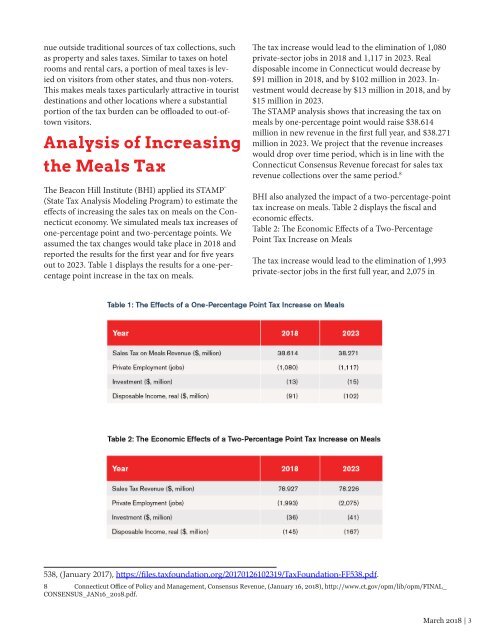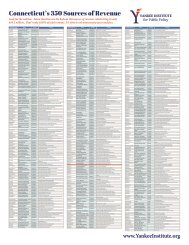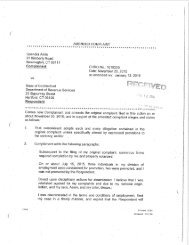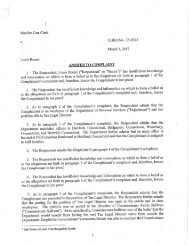Restaurant tax
You also want an ePaper? Increase the reach of your titles
YUMPU automatically turns print PDFs into web optimized ePapers that Google loves.
nue outside traditional sources of <strong>tax</strong> collections, such<br />
as property and sales <strong>tax</strong>es. Similar to <strong>tax</strong>es on hotel<br />
rooms and rental cars, a portion of meal <strong>tax</strong>es is levied<br />
on visitors from other states, and thus non-voters.<br />
This makes meals <strong>tax</strong>es particularly attractive in tourist<br />
destinations and other locations where a substantial<br />
portion of the <strong>tax</strong> burden can be offloaded to out-oftown<br />
visitors.<br />
Analysis of Increasing<br />
the Meals Tax<br />
The Beacon Hill Institute (BHI) applied its STAMP ®<br />
(State Tax Analysis Modeling Program) to estimate the<br />
effects of increasing the sales <strong>tax</strong> on meals on the Connecticut<br />
economy. We simulated meals <strong>tax</strong> increases of<br />
one-percentage point and two-percentage points. We<br />
assumed the <strong>tax</strong> changes would take place in 2018 and<br />
reported the results for the first year and for five years<br />
out to 2023. Table 1 displays the results for a one-percentage<br />
point increase in the <strong>tax</strong> on meals.<br />
The <strong>tax</strong> increase would lead to the elimination of 1,080<br />
private-sector jobs in 2018 and 1,117 in 2023. Real<br />
disposable income in Connecticut would decrease by<br />
$91 million in 2018, and by $102 million in 2023. Investment<br />
would decrease by $13 million in 2018, and by<br />
$15 million in 2023.<br />
The STAMP analysis shows that increasing the <strong>tax</strong> on<br />
meals by one-percentage point would raise $38.614<br />
million in new revenue in the first full year, and $38.271<br />
million in 2023. We project that the revenue increases<br />
would drop over time period, which is in line with the<br />
Connecticut Consensus Revenue forecast for sales <strong>tax</strong><br />
revenue collections over the same period. 8<br />
BHI also analyzed the impact of a two-percentage-point<br />
<strong>tax</strong> increase on meals. Table 2 displays the fiscal and<br />
economic effects.<br />
Table 2: The Economic Effects of a Two-Percentage<br />
Point Tax Increase on Meals<br />
The <strong>tax</strong> increase would lead to the elimination of 1,993<br />
private-sector jobs in the first full year, and 2,075 in<br />
538, (January 2017), https://files.<strong>tax</strong>foundation.org/20170126102319/TaxFoundation-FF538.pdf.<br />
8 Connecticut Office of Policy and Management, Consensus Revenue, (January 16, 2018), http://www.ct.gov/opm/lib/opm/FINAL_<br />
CONSENSUS_JAN16_2018.pdf.<br />
March 2018 | 3







